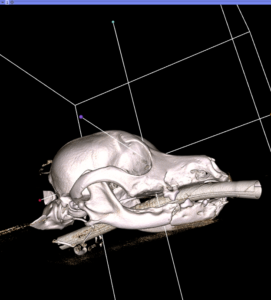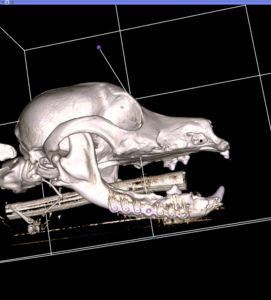
14 Nov Jaw Fracture Repair Using Miniplates
Jaw fractures can occur in pets for a variety of reasons. Over the years, we have seen dogs and cats that were bitten by other dogs, hit by cars, kicked by horses, and even a cat who fell from a fourth-floor window- and survived! Symptoms of a jaw fracture can include bleeding from the mouth, inability to close the mouth and bleeding from the nose. If you witness your pet’s accident or suspect that there has been a jaw fracture, it is important to get to a veterinary emergency hospital immediately for supportive care. It is not uncommon for pets with injuries to the jaw to also have brain trauma or injuries to internal organs. Jaw fracture repair may need to wait until the pet is stable enough for surgery.
Jaw Fractures Due to Periodontal Disease
There is a subset of jaw fractures that can occur due to periodontal disease. This is most common in older small-breed dogs. The lower jaw becomes so weak from bone loss around the teeth, that it fractures from minor pressure. Patients with this type of “pathologic” fracture, don’t always have the swelling, bruising, and bleeding that occur with major trauma. While removing diseased teeth may stop further weakening of the jaw, the remaining bone is so unhealthy that it can be difficult to repair. Pathologic fractures of the jaw can be prevented by making sure your pet gets regular professional dental care with full-mouth dental radiographs.
Treatment Options for Jaw Fracture Repair
At Animal Dental Care & Oral Surgery, we offer a variety of options for fracture repair including plating of jaw fractures using the same type of titanium miniplates and screws used in human maxillofacial surgery. Titanium miniplates offer many advantages in fracture repair. Titanium is a biocompatible material. The plates and screws can be incorporated in the healing bone and a second surgery to remove them is not necessary. Miniplate fixation allows the patient to return to function soon after surgery. With proper alignment and rigid fixation of the fracture, patients are generally comfortable enough to eat when they wake up from surgery.
The following images are from a recent case where a 17-year-old dachshund fractured his right lower jaw fighting over a bone with another dog in the home. There is a pre- operative image followed by a post-operative image. The post-op image is slightly distorted as the metal in the plate creates artifacts during CBCT imaging. The surgery to repair the fracture went smoothly and the dog was able to go home the same day and eat dinner that night. The post-op image is slightly distorted around the fracture site as the metal in the plate creates artifacts during CBCT imaging.

Image A: Pre-Op CT Scan

Image B: A Post-Op CT Scan
Other options for jaw fracture repair include intraoral splints, interfragmentary wiring and maxillomandibular fixation (MMF). With a splint, a second anesthetic procedure is required to remove the splint. Interfragmentary wiring uses stainless steel wires threaded through the bone. The wires often need to be removed after the fracture heals and the fixation is not as stable as plating. MMF includes different techniques to limit or eliminate jaw movement such as wearing a muzzle, bonding teeth together or using suture and labial buttons. Miniplate fixation offers the advantage of excellent healing with only one procedure needed.
Animal Dental Care & Oral Surgery in Fort Collins is currently the only hospital in northern Colorado offering miniplate fixation of jaw fractures.



